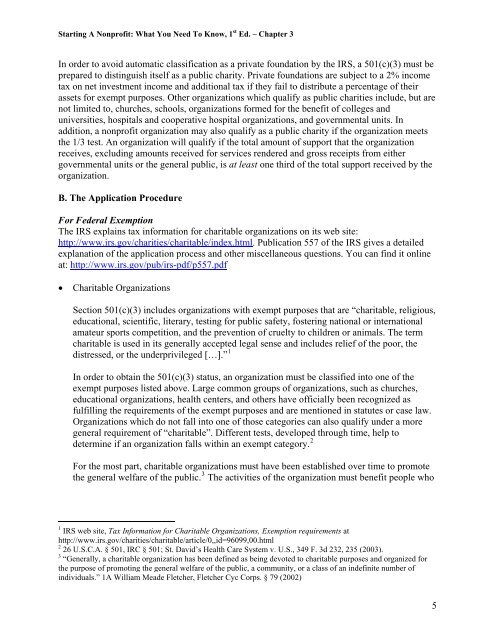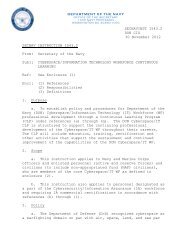HowToFormANonprofit_1st_ed-Chapter3
HowToFormANonprofit_1st_ed-Chapter3
HowToFormANonprofit_1st_ed-Chapter3
You also want an ePaper? Increase the reach of your titles
YUMPU automatically turns print PDFs into web optimized ePapers that Google loves.
Starting A Nonprofit: What You Ne<strong>ed</strong> To Know, 1 st Ed. – Chapter 3<br />
In order to avoid automatic classification as a private foundation by the IRS, a 501(c)(3) must be<br />
prepar<strong>ed</strong> to distinguish itself as a public charity. Private foundations are subject to a 2% income<br />
tax on net investment income and additional tax if they fail to distribute a percentage of their<br />
assets for exempt purposes. Other organizations which qualify as public charities include, but are<br />
not limit<strong>ed</strong> to, churches, schools, organizations form<strong>ed</strong> for the benefit of colleges and<br />
universities, hospitals and cooperative hospital organizations, and governmental units. In<br />
addition, a nonprofit organization may also qualify as a public charity if the organization meets<br />
the 1/3 test. An organization will qualify if the total amount of support that the organization<br />
receives, excluding amounts receiv<strong>ed</strong> for services render<strong>ed</strong> and gross receipts from either<br />
governmental units or the general public, is at least one third of the total support receiv<strong>ed</strong> by the<br />
organization.<br />
B. The Application Proc<strong>ed</strong>ure<br />
For F<strong>ed</strong>eral Exemption<br />
The IRS explains tax information for charitable organizations on its web site:<br />
http://www.irs.gov/charities/charitable/index.html. Publication 557 of the IRS gives a detail<strong>ed</strong><br />
explanation of the application process and other miscellaneous questions. You can find it online<br />
at: http://www.irs.gov/pub/irs-pdf/p557.pdf<br />
• Charitable Organizations<br />
Section 501(c)(3) includes organizations with exempt purposes that are “charitable, religious,<br />
<strong>ed</strong>ucational, scientific, literary, testing for public safety, fostering national or international<br />
amateur sports competition, and the prevention of cruelty to children or animals. The term<br />
charitable is us<strong>ed</strong> in its generally accept<strong>ed</strong> legal sense and includes relief of the poor, the<br />
distress<strong>ed</strong>, or the underprivileg<strong>ed</strong> […].” 1<br />
In order to obtain the 501(c)(3) status, an organization must be classifi<strong>ed</strong> into one of the<br />
exempt purposes list<strong>ed</strong> above. Large common groups of organizations, such as churches,<br />
<strong>ed</strong>ucational organizations, health centers, and others have officially been recogniz<strong>ed</strong> as<br />
fulfilling the requirements of the exempt purposes and are mention<strong>ed</strong> in statutes or case law.<br />
Organizations which do not fall into one of those categories can also qualify under a more<br />
general requirement of “charitable”. Different tests, develop<strong>ed</strong> through time, help to<br />
determine if an organization falls within an exempt category. 2<br />
For the most part, charitable organizations must have been establish<strong>ed</strong> over time to promote<br />
the general welfare of the public. 3 The activities of the organization must benefit people who<br />
1 IRS web site, Tax Information for Charitable Organizations, Exemption requirements at<br />
http://www.irs.gov/charities/charitable/article/0,,id=96099,00.html<br />
2 26 U.S.C.A. § 501, IRC § 501; St. David’s Health Care System v. U.S., 349 F. 3d 232, 235 (2003).<br />
3 “Generally, a charitable organization has been defin<strong>ed</strong> as being devot<strong>ed</strong> to charitable purposes and organiz<strong>ed</strong> for<br />
the purpose of promoting the general welfare of the public, a community, or a class of an indefinite number of<br />
individuals.” 1A William Meade Fletcher, Fletcher Cyc Corps. § 79 (2002)<br />
5





